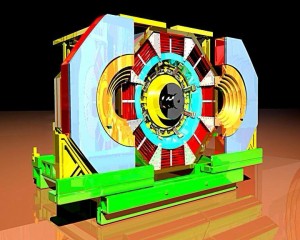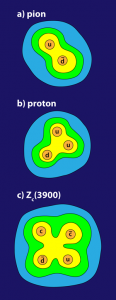 Dos equipos de investigadores, trabajando de manera independiente en distintos aceleradores de partículas, han hallado evidencias de la existencia de lo que parece ser una partícula formada por cuatro quarks. El descubrimiento de esta partícula por los dos equipos, denominada Zc(3900), ha sido detallado en sendos artículos en la revista Physical Review Letters.
Dos equipos de investigadores, trabajando de manera independiente en distintos aceleradores de partículas, han hallado evidencias de la existencia de lo que parece ser una partícula formada por cuatro quarks. El descubrimiento de esta partícula por los dos equipos, denominada Zc(3900), ha sido detallado en sendos artículos en la revista Physical Review Letters.
 Los experimentos involucrados, Belle y BESIII, en Japón y China respectivamente, se hallaban inmersos en el estudio de la partícula Y(4260), descubierta en 2005 y compuesta según parece por dos quarks, encanto y anti-encanto, y un gluón extra (además de los dos encargados de mantener enlazados los dos quarks). Aparte de este gluón extra, la partícula Y(4260) es semejante al encantonio, y en su desintegración ambos equipos descubrieron un pico de energía entorno a los 3.9 GeV, lo cual se corresponde con unas cuatro veces el peso de un protón. Ello sugirió la existencia de una partícula con cuatro quarks, algo nunca antes visto.
Los experimentos involucrados, Belle y BESIII, en Japón y China respectivamente, se hallaban inmersos en el estudio de la partícula Y(4260), descubierta en 2005 y compuesta según parece por dos quarks, encanto y anti-encanto, y un gluón extra (además de los dos encargados de mantener enlazados los dos quarks). Aparte de este gluón extra, la partícula Y(4260) es semejante al encantonio, y en su desintegración ambos equipos descubrieron un pico de energía entorno a los 3.9 GeV, lo cual se corresponde con unas cuatro veces el peso de un protón. Ello sugirió la existencia de una partícula con cuatro quarks, algo nunca antes visto.
Ambos equipos, junto con físicos del resto del mundo, continuarán con sus experimentos, principalmente orientados a determinar si estos equipos han encontrado algo genuínamente nuevo, o el comportamiento aún desconocido de partículas ya descubiertas con anterioridad.
Ver:
- Observation of a Charged Charmoniumlike Structure in e+e-??+?-J/? at ?s=4.26??GeV, M. Ablikim et al. (BESIII Collaboration), Phys. Rev. Lett. 110, 252001 (2013) (PDF)
Abstract
We study the process e+e-??+?-J/? at a center-of-mass energy of 4.260 GeV using a 525??pb-1 data sample collected with the BESIII detector operating at the Beijing Electron Positron Collider. The Born cross section is measured to be (62.9±1.9±3.7)??pb, consistent with the production of the Y(4260). We observe a structure at around 3.9??GeV/c2 in the ?±J/? mass spectrum, which we refer to as the Zc(3900). If interpreted as a new particle, it is unusual in that it carries an electric charge and couples to charmonium. A fit to the ?±J/? invariant mass spectrum, neglecting interference, results in a mass of (3899.0±3.6±4.9)??MeV/c2 and a width of (46±10±20)??MeV. Its production ratio is measured to be R=(?(e+e-??±Zc(3900)???+?-J/?)/?(e+e-??+?-J/?))=(21.5±3.3±7.5)%. In all measurements the first errors are statistical and the second are systematic. - Study of e+e-??+?-J/? and Observation of a Charged Charmoniumlike State at Belle, Z. Q. Liu et al (Belle Collaboration), Phys. Rev. Lett. 110, 252002 (2013) (PDF)
Abstract
The cross section for e+e-??+?-J/? between 3.8 and 5.5 GeV is measured with a 967??fb-1 data sample collected by the Belle detector at or near the ?(nS) (n=1,2,…,5) resonances. The Y(4260) state is observed, and its resonance parameters are determined. In addition, an excess of ?+?-J/? production around 4 GeV is observed. This feature can be described by a Breit-Wigner parametrization with properties that are consistent with the Y(4008) state that was previously reported by Belle. In a study of Y(4260)??+?-J/? decays, a structure is observed in the M(?±J/?) mass spectrum with 5.2? significance, with mass M=(3894.5±6.6±4.5)??MeV/c2 and width ?=(63±24±26)??MeV/c2, where the errors are statistical and systematic, respectively. This structure can be interpreted as a new charged charmoniumlike state.
Leave a Reply